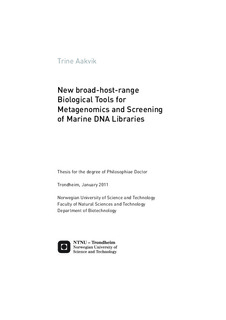| dc.contributor.author | Aakvik, Trine | nb_NO |
| dc.date.accessioned | 2014-12-19T13:14:32Z | |
| dc.date.available | 2014-12-19T13:14:32Z | |
| dc.date.created | 2011-08-15 | nb_NO |
| dc.date.issued | 2011 | nb_NO |
| dc.identifier | 434323 | nb_NO |
| dc.identifier.isbn | 978-82-471-2604-2 (printed ver.) | nb_NO |
| dc.identifier.isbn | 978-82-471-2605-9 (electronic ver.) | nb_NO |
| dc.identifier.uri | http://hdl.handle.net/11250/245714 | |
| dc.description.abstract | The fact that only a minority of the microorganisms in environmental samples can be cultivated in the laboratory necessitates the use of metagenomics to better explore and exploit the huge source of genetic diversity represented by these organisms. Metagenomic sequencing studies allow for characterization of the microbial community within a selected habitat, whereas functional screening of metagenomic libraries is accomplished with the aim to detect novel biomolecules. The latter approach has the advantage that it does not rely on any sequencehomology to known genes, but it is dependent on successful heterologous expression of environmental-originating genes within the library host.
As the chances for heterologous expression increases when using many different species as hosts for such libraries, the initial objective of the work presented here was to establish a broad-hostrange vector system suitable for such metagenomic studies. The resulting RK2-based vector pRS44 is a combined fosmid and BAC vector that can be used for large-insert library construction followed by efficient transfer of intact library clones to numerous hosts through conjugation. The copy number of pRS44 is adjustable meaning that gene expression levels can easily be modified.
It was observed that large plasmids were occasionally modified after conjugal transfer when using the traditional conjugation donor strain Escherichia coli S17-1. Analysis of these occurrences revealed that they most probably result from co-transfer of DNA from the chromosomally located oriT, followed by homologous recombination events in the recipient host. An improved mobilization system that does not contain a functional oriT has therefore been established, and this system also circumvent other problems that have been reported for the S17-1 donor system. It is in addition more flexible as the mobilization helper plasmid is replicating extra-chromosomally through the broad-host-range replicon pBBR1, meaning that it can be transferred to different strains and species for the establishment of new donors.
The pRS44 vector was used to establish a 20000 member metagenomic library using DNA isolated from marine sediments as cloning material. This library was screened mainly for pigment- and antibiotic production using both sequence-based and function-based approaches, the latter on library clones of both E. coli and P. fluorescens. Characterization of a metagenomic clone producing a pigmented compound, both at gene and product level, revealed that the pigment was a melanin-like polymer and the responsible gene product was very similar to the oxidoreductase rubrerythrin. No connections have to our knowledge earlier been made between this enzyme-class and melanins.
This PhD thesis also includes some work connected to a sequence-based study on metagenomic DNA isolated from a Norwegian oil reservoir. The main findings in this study were that the sequenced DNA was unexpectedly similar to DNA isolated from more accessible locations, and that the dominating microorganisms within this reservoir were sulphur-reducing bacteria and methanogens (archaea). All analyses indicate that the sequence data represents the community at high coverage. As a fraction of the sequences showed similarities to mesophilic species, a gene sequence annotated to encode an enolase from the mesophilic specie Pelobacter carbinolicus was synthesized and expressed in E. coli. The activity of this enolase proved to be more temperature tolerant than the corresponding E. coli enzyme, and it was therefore assumed that the sequence rather originate from a thermophilic Pelobacter -like specie. | nb_NO |
| dc.language | eng | nb_NO |
| dc.publisher | Norges teknisk-naturvitenskapelige universitet, Fakultet for naturvitenskap og teknologi, Institutt for bioteknologi | nb_NO |
| dc.relation.ispartofseries | Doktoravhandlinger ved NTNU, 1503-8181; 2011:41 | nb_NO |
| dc.relation.haspart | Aakvik, T.; Drabløs, F.; Andreassen, T.; Valla, S.. Production in <em><em>Escherichia coli </em></em>of a melanin-like polymer from a marine sediment metagenomic clone expressing rubrerythrin. . | nb_NO |
| dc.relation.haspart | Kotlar, H.K.; Lewin, A.; Johansen, J.; Throne-Holst, M.; Haverkamp, T.; Markussen, S.; Winnberg, A; Ringrose, P; Aakvik,, T.; Ryeng, E.; Jakobsen, K.; Drabløs, F.; Valla, S.. High coverage sequencing of DNA from ancient microorganisms living at 250 bars 2.5 kilometers subsurface in a Norwegian sea oil reservoir. . | nb_NO |
| dc.title | New broad-host-range Biological Tools for Metagenomics and Screening of Marine DNA Libraries | nb_NO |
| dc.type | Doctoral thesis | nb_NO |
| dc.contributor.department | Norges teknisk-naturvitenskapelige universitet, Fakultet for naturvitenskap og teknologi, Institutt for bioteknologi | nb_NO |
| dc.description.degree | PhD i bioteknologi | nb_NO |
| dc.description.degree | PhD in Biotechnology | en_GB |

